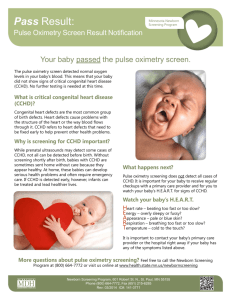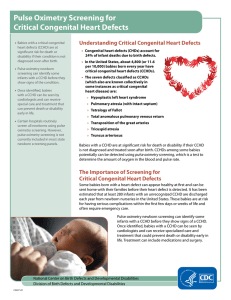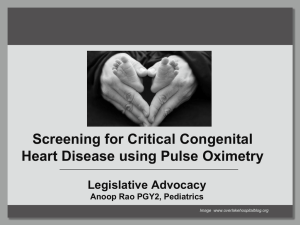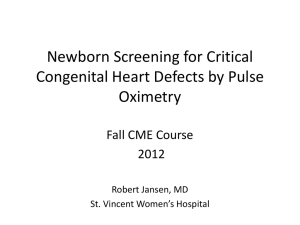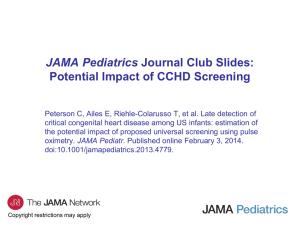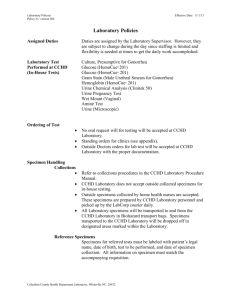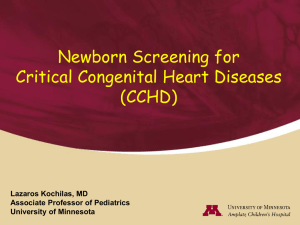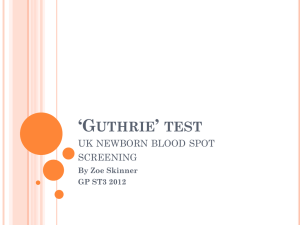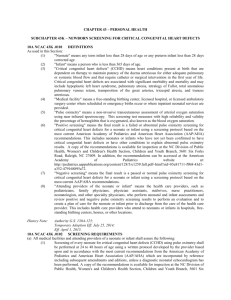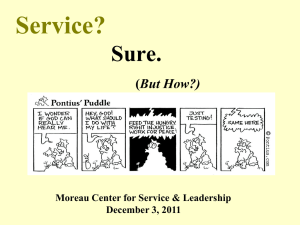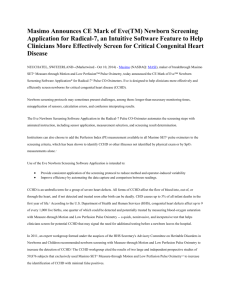Pulse oximetry screening for congenital heart
advertisement
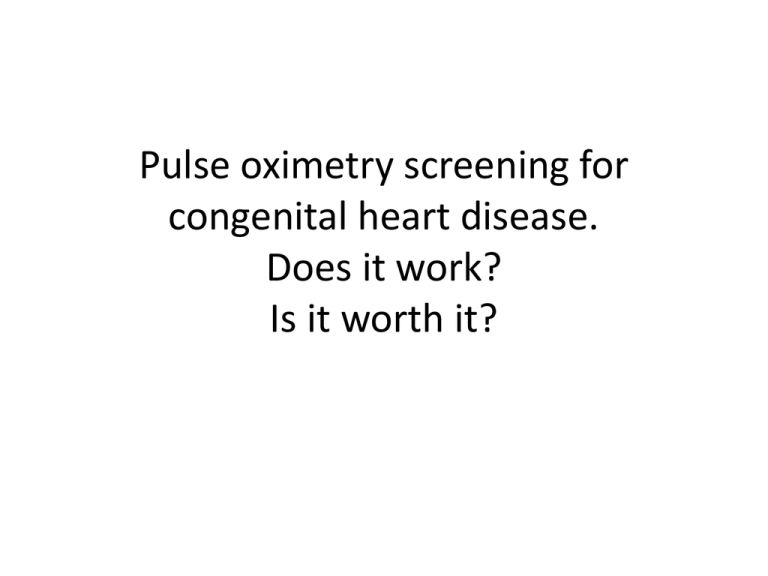
Pulse oximetry screening for congenital heart disease. Does it work? Is it worth it? Congenital Heart Disease • Most common group of congenital anomalies • About 1 in every 100 babies – Depends on definition – If you include all ASD, VSD found on screening ultrasounds, 1% • At least 8 per thousand have anomly with clinical impact Congenital Heart Disease • Sometimes not detected before discharge home • Infants with CHD who present after a serious deterioration have higher mortality and higher morbidity • Often, patients who had duct dependent lesions, who present when the duct closes Congenital Heart Disease • Can we detect CHD before that happens • Antenatal screening • Postnatal screening The target diagnosis • Critical congenital heart disease (CCHD) • CHD which is duct dependant and may cause sudden severe illness after PDA closure, and CHD which requires surgery in the 1st 28 days of life • Includes most cyanotic CHD, and left heart obstructive lesions How many CCHD are missed? • Most pregnant women have a morphology scan around 20 weeks gestation • All babies born in hospital have a physical exam before hospital discharge • Nevertheless at least 20% of babies with CCHD are discharged without a diagnosis (data from UK) CCHD in Canada • Are we missing CCHD in Canada? • No recent data • CCHD about 1 per 1000 births • If we are better than any other jurisdiction, then about 10% not diagnosed before discharge • 1 baby in every 10,000 discharged from hospital with CCHD without diagnosis Does Oximetry Screening work? • Several very large studies • de Wahl-Granelli – Only 2 antenatal diagnoses, 40,000 babies • Ewer – 23 antenatal diagnoses, 20,000 babies Is there a lot of extra work for the cardiologists? • False positive rate between 0.1% and 1% • Much lower if tested after 24 hours • False positive of physical examination 2% False positives • Many ‘false positives’ actually have diseases that need therapy, or follow up • Respiratory disease with desaturation • CHD which is not ‘critical` • Pulmonary hypertension Do false positives worry parents? • UK study of 20000 babies • 119 false positives • Asked the mothers • No increase in anxiety • Sensitivity is around 75% • Sensitivity of physical exam alone 66% • Combined sensitivity of oximetry with physical exam 83% False negatives • 17% of infants with CCHD which was not diagnosed antenatally will still be discharged without diagnosis • Mostly Coarctations, IAA occasionally others (TGA…) • Must be sure that parents know (just as with other screens) that a negative screen is not 100%, and babies still need normal health care Is it worth it? • Neonatal Screening costs • How to calculate the benefit • CCHD screening by pulse oximetry in a society which has widespread morphology ultrasounds • About 25000$ per extra case of CCHD detected • A bit more expensive than hearing screening • Much cheaper than MassSpec • CCHD is treatable! Evidence based recommendations • Screen before discharge • After 24 hours is preferable (same recommendations as hearing screen) • Motion resistant pulse oximeter • Foot saturation <95% +|- right hand to foot difference >3% – Either simultaneous or do foot first, then right hand if foot is 95% or 96% • Immediate physical exam, if completely normal repeat oximetry • If repeat abnormal, or physical exam abnormal, echocardiography, the same day. neonatalresearch.org
